
State and local agencies are some of the most attractive and vulnerable targets for cyber criminals. In 2023, malware attacks increased by 148%, and ransomware incidents increased by 51%. These agencies are targeted because they hold valuable personal data on citizens and control critical services--yet their security efforts have historically been underfunded and under-resourced. However, the tide may be changing.
A report on the ransomware experiences of state and local government in 2024 showed a dramatic decrease in the number of those organizations that were impacted this year. The report found ransomware attacks impacting 34% of state and local governments, marking a sharp decrease from the 69% affected in 2023. Let's take a look at some of the trends and activities that are fueling the improvement in state and local cybersecurity. Continue reading

 The operating challenges around budgets, resources, and legacy technology we see at the Federal level are amplified at the state and local level. Just because these groups are responsible for a smaller population does not mean their problems are smaller. On the contrary, historically low staffing levels and a geographically-limited pool of talent feed into the
The operating challenges around budgets, resources, and legacy technology we see at the Federal level are amplified at the state and local level. Just because these groups are responsible for a smaller population does not mean their problems are smaller. On the contrary, historically low staffing levels and a geographically-limited pool of talent feed into the 



